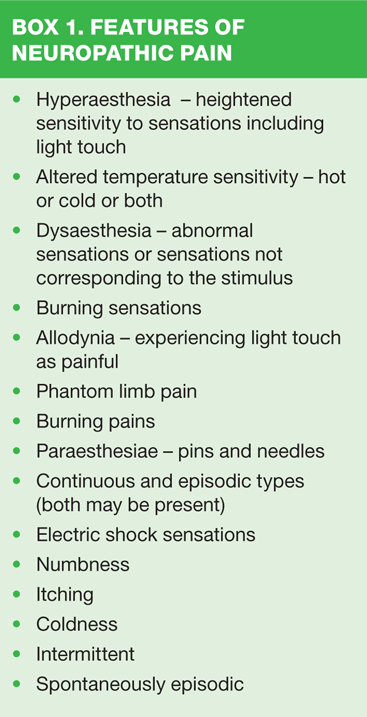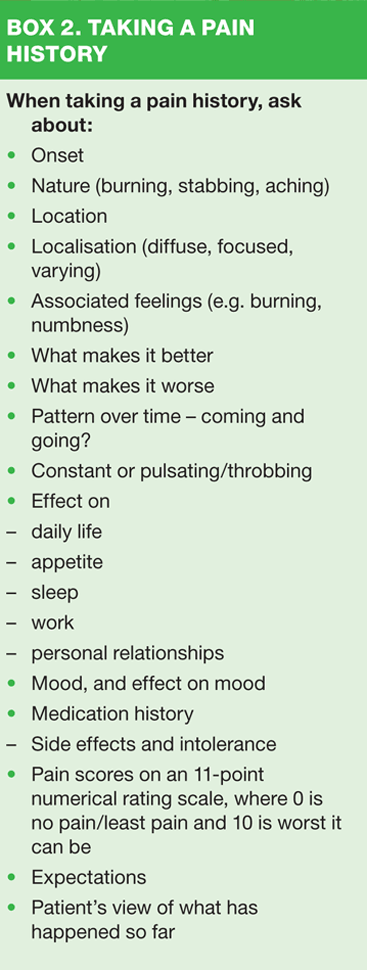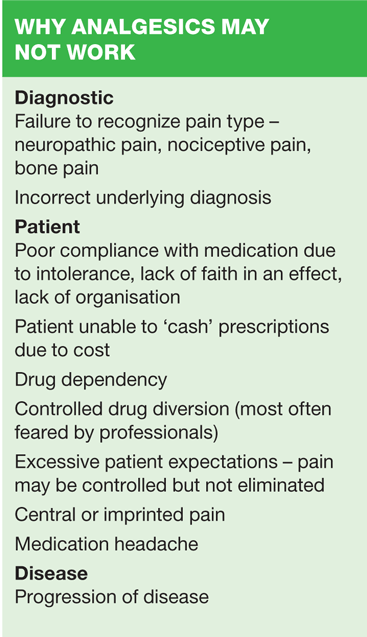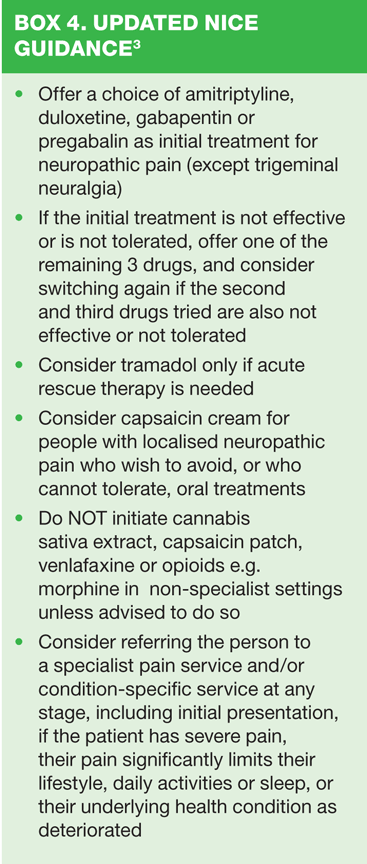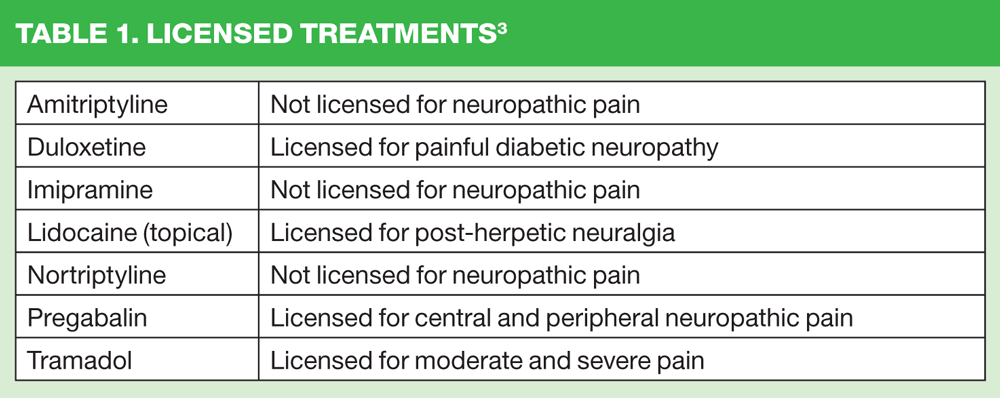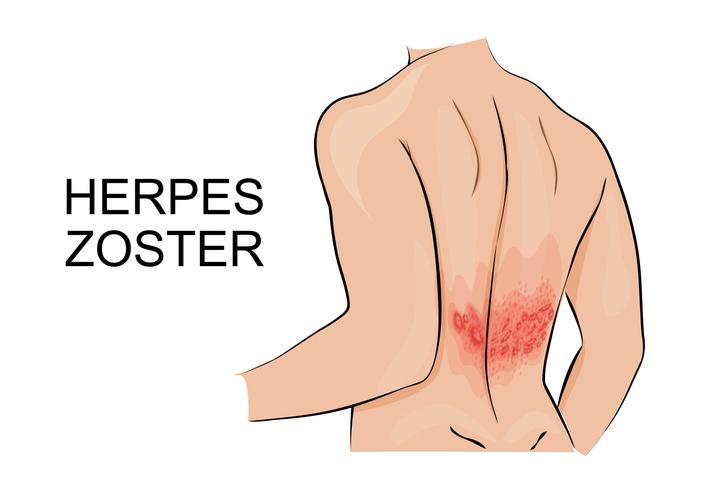
Shingles and neuropathic pain
Dr Mary Lowth
Dr Mary Lowth
MA MB BChir FRCGP PGCME GP
MRCGP examiner and medical educatorst
The practice nurse will often see patients presenting with pain, but there is more than one type of pain and therefore, crucially, more than one approach to management
Neuropathic pain is a particular sort of pain which is caused by nerve injury and which responds only partially or, sometimes, not at all, to 'traditional' analgesics such as paracetamol and opiates.
Postherpetic neuralgia (PHN) is a form of neuropathic pain that can follow an attack of shingles.
In this article we discuss the pharmacological and non-pharmacological approaches that may help to manage neuropathic pain and minimize its occurrence after shingles.
Neuropathic pain is common.1,2 The practice nurse will frequently see patients who are in pain, sometimes incidental to the consultation (they might have come in for a dressing, or a blood pressure review), but sometimes it will be central to their attendance.
Pain is distressing for patients and healthcare professionals and if the pain is chronic its likely that many treatments will have been tried.
The practice nurse can pay a huge role in taking a fresh look at the patient's pain, taking a new pain history and looking for possible presence of undertreated neuropathic pain.
WHAT IS NEUROPATHIC PAIN?
Neuropathic pain is caused by damaged or malfunctioning nerves,3 and can originate in the peripheral or central nervous system.
Central neuropathic pain originates in the brain and spinal cord and may be due to physical injury such as trauma, or injury by disease processes such as multiple sclerosis or stroke.
Peripheral neuropathic pain originates with damage to peripheral nerves, most commonly due to diabetes, closely followed by the post-herpetic neuralgia of shingles. Other causes include vitamin deficiencies, damage to or pressure on nerves from tumours, vertebral collapse, prolapsed intervertebral disc, carpal tunnel syndrome, HIV, radiotherapy, burns and chemotherapy.
Some cancers produce inflammatory molecules which can cause neuropathic pain at sites distant from the tumour itself: neuropathic pain is common in cancer.
The mechanisms of long-term neuropathic pain can include abnormal regeneration of damaged nerves, and sensitisation (or altered pain thresholds) both peripherally and centrally.
HOW COMMON IS NEUROPATHIC PAIN?
Surveys suggest that 7-8% of people in Europe are affected by neuropathic pain, many with diabetic neuropathy.1,2 This figure is likely to rise over time with the increasing prevalence of diabetes.
WHAT IS NEUROPATHIC PAIN LIKE?
All pain is unpleasant, and like any pain neuropathic pain may be more or less severe — so in this sense it is no worse or better than nociceptive pain.
However, neuropathic pain has a number of characteristic features which should alert you to its presence in the patient before you. These include burning or tingling, electric shock-like sensations, hyperaesthesia, dysaesthesia and allodynia.3 These terms are defined in Box 1. Nociceptive pain, on the other hand, is often described as dull and aching, and lacks the unusual qualities of altered sensations, numbness and tingling.
It is important to remember that it is common for both types of pain to be present simultaneously, particularly in cases of tissue injury and inflammation, such as cancer and central nervous system (CNS) trauma.
DETECTING NEUROPATHIC PAIN: TAKING A PAIN HISTORY
The essential features of a pain history are shown in Box 2, but far more important than knowing what to ask is reminding yourself to ask it in the first place.
The fact that someone has presented many times with the same pain does not mean there is no value in a fresh pain history. Ask again, and remember that pain may change over time, but may do this so subtly that patients are not really aware of it themselves. They may need to reassess the situation, their symptoms and their expectations too.
SHINGLES AND NEUROPATHIC PAIN
Shingles is caused by reactivation of the chickenpox virus (herpes zoster) which, after primary infection, lies dormant in the anterior horn cells of peripheral sensory nerves, adjacent to the spine. When the virus reactivates it travels back down nerve axons to infect the skin in the region of the nerve with the classic painful rash. This normally heals in 10-14 days, but residual nerve pain can linger for months or years. This is termed post-herpetic neuralgia, PHN.
PHN normally affects only the area of skin served by the nerve affected by the shingles attack, and is probably due to nerve damage by the virus. The pain can be excruciating.
Factors which make developing PHN more likely are listed in Box 3.
Prevention of post herpetic neuralgia (PHN)
Unfortunately there is nothing that perfectly prevents PHN, but vaccination has been shown to reduce the incidence of herpes zoster by 51.3% in a study of 38,000 adults aged 60 and older who received the vaccine. The vaccine also reduced by 66.5% the number of cases of PHN and reduced the severity and duration of pain and discomfort associated with shingles, by 61.1%.4,5
Starting antiviral therapy early — within 72 hours of onset — may reduce the chance of PHN.
Oral amitriptyline started in the first two days of the shingles also reduces the incidence of PHN.
Oral steroids don't prevent PHN although they are used in ophthalmic shingles to reduce the inflammatory response in the eye.
TREATMENT
Treatment of neuropathic pain can be difficult and like most common pain, it may be necessary to aim for management rather than cure. Most evidence for treatment has been gathered from studying post herpetic pain and diabetic neuropathy, but it is likely that what we have learned can be translated to treatment of other causes of nerve pain.
Non-pharmacological treatments
The first and most important thing is to recognize a neuropathic pain element in the patient's symptoms and share your understanding with them. Your explanation to the patient will need to be tailored to their understanding and needs — but as for many people fear of the unknown is an important factor in pain, this in itself may help.
Patients should be encouraged to keep a pain score, marking severity on 11-point numeric rating scale, where 0 is no pain at all, and 10 is the worst imaginable pain. They need to define at what level their pain is bearable and what level they would realistically be prepared to live with.6
Doing this may provide patients with a different view of the success you and they are having at managing their pain.
Other non-pharmacological approaches include:
Psychological/cognitive strategies, such as cognitive behavioural therapy (CBT) can help manage the patient's response to the pain.
Other treatments for neuropathic pain are similar to those for all pain:
- Exercise, activity and socialising to improve mood, and as a distractor from pain.
- Pacing the day to break up tasks.
- Relaxation therapies such as audiotapes, massage and meditation.
- Transcutaneuous electrical nerve stimulation (TENS) devices, which deliver a tingling sensation to the skin near the site of pain and may mask the pain or distract from it.
Some patients find rubbing, or warming affected areas with heated wheat bags helpful.
Eating foods with a high thiamine content, e.g. yeast, wholegrain cereals, beans and nuts, or taking a thiamine supplement, may be helpful for diabetic neuropathy.
Pharmacological treatments
Neuropathic pain can be very difficult to treat and not all patients achieve even partial relief. Working out what's best can be a challenge since all patients are different — and there is unlikely to be a single best answer for any one patient. But there are a number of guidelines available, including the recently updated clinical guidance from NICE.3 (Box 4)
The drugs that are used are usually classified according to their licensed indication — thus antidepressants, anti-epileptics and others have specific use in neuropathic pain. Not all are licensed for use in neuropathic pain (Table 1). This is important as when prescribing off license, good practice expects us to inform patients of this fact and what it means. However, one can add that the use of such drugs to treat pain is tried and tested and evidence based.
These drugs work because some of the transmitter systems and conduction channels involved in neuropathic pain are also involved in other conditions..
Most commonly used treatments are certain antidepressants e.g. amitriptyline, selective serotonin-norepinephrine reuptake inhibitors (SNRIs), anticonvulsants, especially pregabalin and gabapentin, and topical lidocaine. Opioid analgesics have their uses and may be helpful adjuncts.
Some drug treatments for neuropathic pain will also benefit nociceptive pain, even though the reverse is not always true. Not all drugs will work for all patients, and many have to be taken in gradually increasing doses to manage intolerance, and may need to be tapered off upon discontinuation to manage withdrawal syndromes.
Antidepressants
Patients may need to be reassured that antidepressants will relieve neuropathic pain in patients who are not depressed, and that they are not being labeled as depressed. NICE recommends offering amitriptyline (a tricyclic antidepressant) or duloxetine (an SNRI) for all neuropathic pain except for trigeminal neuralgia.(Box 4)
Anticonvulsants
Pregabalin and gabapentin are also recommended for all neuropathic pain (Box 4) except trigeminal neuralgia where carbamazepine is the recommended initial treatment. Lamotrigine can be helpful after stroke and in HIV neuropathy.
Opioids
Opioids are not first line treatments in neuropathic pain. Methadone is frequently used as it affects specific receptors that play a role in neuropathic pain. Tramadol should only be considered as 'rescue' analgesia because of concerns about long-term use.3
Topical agents
In some forms of neuropathy, especially post-herpetic neuralgia, topical anaesthetics like lidocaine (a slow release patch is available), or topical anti-inflammatories can provide relief.
Topical capsaicin, a chilli-like substance found naturally in peppers, can be extremely helpful in reducing abnormal skin sensitivity, and can be considered for patients with localized neuropathic pain who wish to avoid, or cannot tolerate, oral treatments.3
Cannabinoids
Cannabis sativa extract is approved as a pain medication in many countries but in the UK should not be initiated outside specialist pain centres.3 It may be beneficial in HIV neuropathy.
THE PATIENT IN PAIN: AFFECT AND APPROACH
Neuropathic pain, particularly when longstanding, can be a source of enormous misery for patients. Moreover it can result in overmedication with opiates and non-steroidal anti-inflammatory drugs as healthcare professionals struggle to manage it without success.
People who are depressed experience worse pain. Indeed all pain has two components — the pain itself and our emotional and psychological response to it.
The meaning of pain to the patient is also very important. The pain of a progressing malignancy may be associated with fear, anticipation and helplessness whereas PHN pain has the possibility of a cure and considerably less uncertainty.
Patients expectations may need adjustment. It can be an enormous issue for patients to reduce their expectations from being pain free — which they may never achieve — to a situation in which their pain is, at least, more manageable than it currently is. This is compounded by altered sensitivity to the pain and feelings of hopelessness and despair.
It's important, when treating neuropathic pain, to bear all this in mind. If the patient does not believe that you can help them then you are unlikely to do so. Making rash promises about what they can expect from your treatment will only worsen this 'doom-loop'. It's important to be hopeful but realistic, and to approach issues in partnership with the patient.
CONCLUSION
There are many sets of published guidance on pain management, most of which take account of treatment cost. NICE guidance addresses this and has given us some building blocks and guidance upon which to build our management plans for patients with neuropathic pain.
Under-treatment of any pain leads to anxious patients, loss of trust in us and a sense of failure in health professionals. This can lead us to labeling patients as difficult or demanding, and results in clinicians switching off their diagnostic antennae and adopting a defensive response.
It is always worth a fresh look. Correctly recognising undertreated neuropathic pain can turn this vicious cycle around, and sometimes simple solutions can be found.
REFERENCES
1. International Association for the Study of Pain. Pharmacological management of neuropathic pain. Clinical Updates 2010;18(9). Available online at: http://www.iasp-pain.org/AM/Template.cfm?Section=Home&Template=/CM/ContentDisplay.cfm&ContentID=12215
2. Bouhassira D, Lantéri-Minet M, Attal N, Laurent B, Touboul C (June 2008). Prevalence of chronic pain with neuropathic characteristics in the general population. Pain 136 (3): 380—7.
3. NICE: Neuropathic pain: pharmacological management (CG173). (Updates CG96) Nov 2013. Available at: http://www.nice.org.uk/nicemedia/live/14301/65782/65782.pdf
4. Oxman MN, Levin MJ, Johnson GR, et al. A vaccine to prevent herpes zoster and postherpetic neuralgia in older adults. N Eng J Med 2005;35:2271—84.
5. Oxman MN, Levin MJ, Shingles Prevention Study Group (March 2008). Vaccination against Herpes Zoster and Postherpetic Neuralgia. J Infect Dis 2008;197(Suppl 2):S228—36
6. Royal United Hospital, Bath, Pain Clinic Guidance. Available at: http://www.ruh.nhs.uk/patients/services/clinics/pain_clinic/non_drug_treatments.asp?menu_id=4 accessed 15/3/13
Related articles
View all Articles
